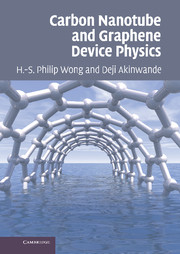Book contents
- Frontmatter
- Contents
- Preface
- 1 Overview of carbon nanotubes
- 2 Electrons in solids: a basic introduction
- 3 Graphene
- 4 Carbon nanotubes
- 5 Carbon nanotube equilibrium properties
- 6 Ideal quantum electrical properties
- 7 Carbon nanotube interconnects
- 8 Carbon nanotube field-effect transistors
- 9 Applications of carbon nanotubes
- Index
5 - Carbon nanotube equilibrium properties
Published online by Cambridge University Press: 05 June 2012
- Frontmatter
- Contents
- Preface
- 1 Overview of carbon nanotubes
- 2 Electrons in solids: a basic introduction
- 3 Graphene
- 4 Carbon nanotubes
- 5 Carbon nanotube equilibrium properties
- 6 Ideal quantum electrical properties
- 7 Carbon nanotube interconnects
- 8 Carbon nanotube field-effect transistors
- 9 Applications of carbon nanotubes
- Index
Summary
Introduction
This chapter explores the equilibrium and thermodynamic electronic properties of single-wall CNTs. Equilibrium refers to the state of a system in the absence of external forces, and thermodynamics accounts for the evolution of the macroscopic properties of the system with temperature. The system we are referring to here is of course CNTs, and the properties of interest include the DOS, group velocity, effective mass, and charge carrier density. These properties are of central importance for understanding and predicting the electrical, optical, and thermal behavior of CNTs. Our learning path will utilize the development of analytical expressions of these properties to provide insight and understanding regarding the inherent solid-state behavior. Additionally, analytical expressions are especially desirable for compact modeling of nanotube devices.
In order to be comfortable with the discussion of the equilibrium properties, the reader should be familiar with the band structure of CNTs developed in the previous chapter. In fact, it will be worthwhile to have in hand a copy of all the band structure figures shown in Chapter 4 as one goes through this chapter. The equilibrium properties will be employed repeatedly in subsequent chapters to describe transport in CNTs under the quasi-equilibrium assumption applicable at low energies. We begin by discussing the DOS of the free-electron gas in 1D space. This provides perspective, allowing us to appreciate and relate to the actual DOS in CNTs which are quasi-1D solids. In general, the DOS is of fundamental importance in understanding crystalline solids, and many of the other equilibrium properties can be derived from this important parameter.
- Type
- Chapter
- Information
- Carbon Nanotube and Graphene Device Physics , pp. 102 - 127Publisher: Cambridge University PressPrint publication year: 2010
- 1
- Cited by



